 .
.Process Modelling Framework (PMF) is a process design and execution framework in OFSAA that facilitates the implementation of process sequences or pipelines. Use the framework to orchestrate Run Pipelines and Business Pipelines, alongside the objects that are a part of these pipelines.
This section provides information about the usage of the Process Modeling Framework (PMF) feature in executing the OIDF processes.
NOTE |
For detailed information about the Process Modeling Framework (PMF) feature in OFSAA, see the Oracle Financial Services Analytical Applications Infrastructure Process Modelling Framework Orchestration Guide Release 8.1.0.0.0. |
Topics:
· Overview
· Process Modeling Framework Roles
· Access the Process Modeling Framework in OIDF
· Use the Process Modelling Framework for OIDF Functions
In OIDF Rule Run Framework (RRF), PMF is used to create a Run definition in a Run process. The visual representation of the Run is enabled through PMF by the construction of a Run Pipeline (process). The set of tasks required to carry out the OIDF functions is managed through PMF. Through the PMF, you can execute the following out-of-the-box Run processes for data loading:
· Oracle Insurance Data Foundation Sourced Run
· Oracle Insurance Data Foundation Execution Run
Before you access PMF for the management of OIDF tasks, ensure to provide specific users with security or access rights. To grant access to the PMF functionality, assign the following PMF Roles to the user.
See the Oracle Financial Services Analytical Applications Infrastructure Process Modelling Framework Orchestration Guide Release 8.1.0.0.0 for details.
Table 33: PMF User Role Codes and Role Names
Role Code |
Role Name |
WFMWRITE |
Manage Workflow Monitor |
WFADMINACC |
Process Admin User |
WFDELACC |
Process Delegation User |
WFACC |
Workflow Access |
WFADV |
Workflow Advanced |
WFAUTH |
Workflow Authorize |
WFDELGADM |
Workflow Delegation Admin |
WFMACC |
Workflow Monitor Access |
WFREAD |
Workflow Read |
WFWRITE |
Workflow Write |
To access the PMF, follow these steps:
1. Log in to
the OIDF application and click Administration .
.
2. In the Information Domain list, select the information domain required for OIDF. Then click the Process Modelling Framework tile.
Figure 51: Select Process Modelling Framework Tile in the Administration Page
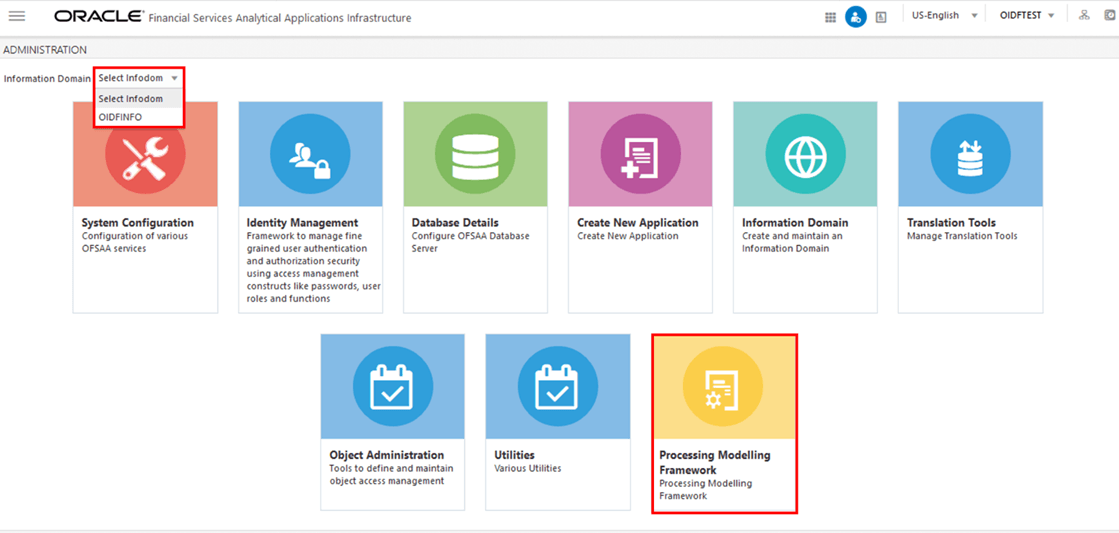
3. A submenu is displayed with the following menu items:
§ To access the Process Modeller, click Process Modeller.
§ To monitor currently running processes, click Process Monitor.
§ To delegate the Run process, click Delegation.
Figure 52: Select the Process Modeller or Process Monitor option in PMF submenu

You can use PMF in one of the following ways to perform OIDF functions or tasks:
· Use Standard OIDF Run Pipelines
· Configure and Manage Custom Pipelines for OIDF Functions
ATTENTION |
Ensure you have executed all the Runs and Batch IDs mentioned in the latest RUN_CHART_SUMMARY sheet of the Oracle Insurance Data Foundation Application Pack Run Chart to access the out-of-the-box Run pipelines mentioned in the Use Standard OIDF Run Pipelines section. |
Use the following Process Modelling Framework features to perform the OIDF functions either by using the standard pipelines (processes) or by creating custom pipelines:
The Process Modeler is used to create and modify types of Pipelines, test the Process Flow, and execute the Run.
This is a sample Process Modeler page in PMF.
Figure 53: Sample Process Modeler page
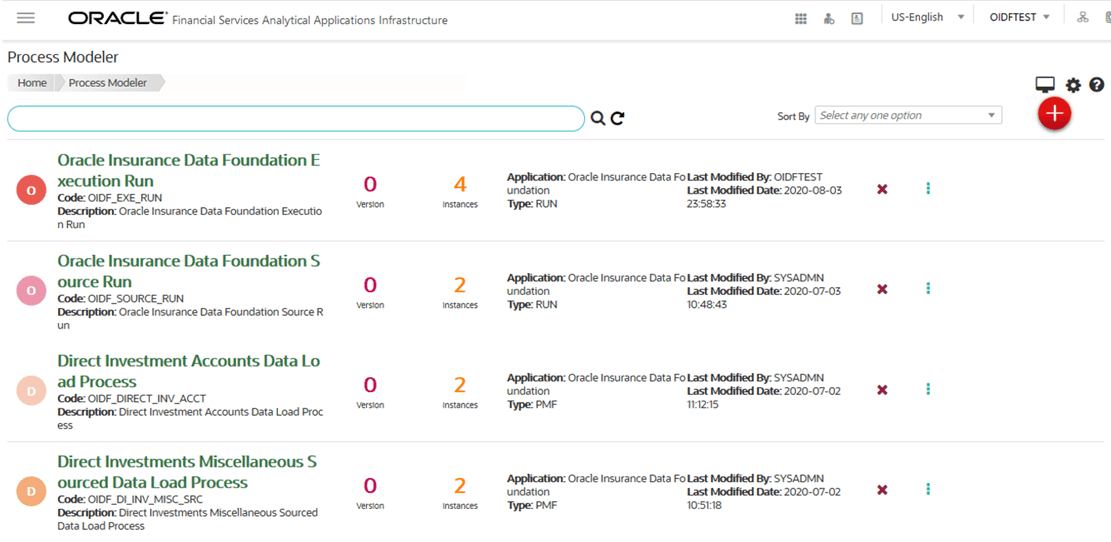
The Process Modeler page displays the existing Business Process Pipelines and Run Pipelines with the details such as Process ID, Process Name, Process Description, Version, Instance, Application, and Last Modified.
You can perform the following tasks from the Process Modeler window:
· Click to create a new Pipeline.
· Click the Process Name link to launch and edit the Process Flow.
· Click to delete a Pipeline.
· Click to view the following submenu:
§ Click View to see the process flow.
§ Click Copy to create a new Pipeline with the same process flow.
§ Click Process Flow Monitor to monitor the Pipeline.
§ Click Test Process Flow to test or check whether the Business Pipeline you designed works as expected.
§ Click Execute Run to execute a Run Pipeline.
§ Click Export Process to export a Process.
NOTE |
The export process is performed using the Object Migration feature. |
· Use the
Search grid to search for a specific Pipeline by providing a keyword from
the Process ID, Process Name, or Process Description and then click Search . Click Reset
. Click Reset to reset the
Search fields.
to reset the
Search fields.
· You can sort the Pipelines based on Process ID, Process Name, or Application. Click the Sort by drop-down and select the required attribute to sort.
· You can use the Filter Pipeline field to filter pipelines based on the pipeline type. For example, to view only the Run Pipelines, remove Process from the Filter Pipeline field.
· Click  to
launch the Process
Monitor page.
to
launch the Process
Monitor page.
The Process Monitor is used to supervise the current stage of the process for different instances. After integration with an application, you can invoke the workflow. After invoking, the workflow goes through all the stages defined. The Process Monitor displays all the completed stages, current stage, and future stages. Your user group must be mapped to the function role Workflow Monitor Access (WFMACC) to access the Process Monitor page. For the list of the PMF Roles, see the Process Modeling Framework Roles section.
This is a sample Process Monitor page in PMF.
Figure 54: Sample Process Monitor Page
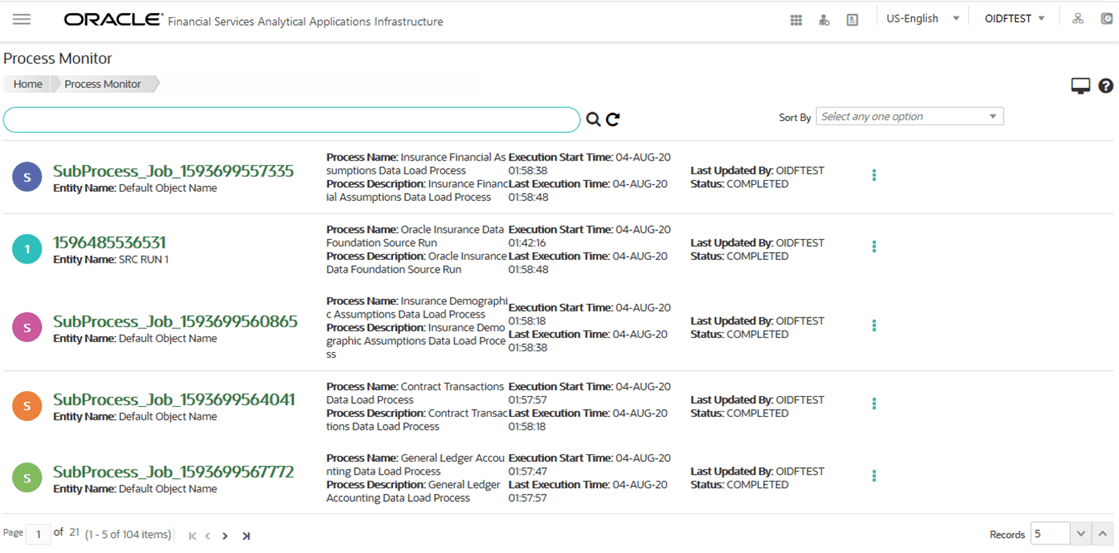
This page displays all the workflows, which are invoked from the application with details such as Entity Name, Process Name, Process Description, Execution Start Time, Last Execution Time, Last Updated By, and Status.
You can perform the following tasks on the Process Monitor page:
· Click  to view
the following submenu:
to view
the following submenu:
Figure 55: Process Monitor with Re-Run, Abort, and Resume options
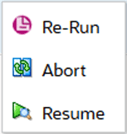
§ Abort: To abort an ongoing Run Pipeline process.
§ Resume: To resume a Run Pipeline process.
§ Re-Run: To execute a Run Pipeline process again irrespective of the previous execution status.
· Use the
Search grid to search for a specific Pipeline
by providing a keyword from the Job ID, Process Name, or Process Description,
and then click Search . Click Reset
. Click Reset to reset the Search fields.
to reset the Search fields.
· You can sort the Pipelines based on Job ID, Process Name, or Application. Click the Sort by list and select the required attribute to sort.
· You can use the Filter Pipeline field to filter pipelines based on the pipeline type. For example, to view only the Run Pipelines, remove Process from the Filter Pipeline field.
· Click  to
open the Process
Modeler page.
to
open the Process
Modeler page.
After OIDF is installed successfully, the following out-of-the-box standard Run pipelines (PMF processes) are available in the PMF:
· Oracle Insurance Data Foundation Sourced Run: This Run pipeline (Process) loads all non-Run enabled tables in OIDF.
· Oracle Insurance Data Foundation Execution Run: This Run pipeline (Process) loads all Run enabled tables in OIDF.
To load all non-Run enabled tables in OIDF using the out-of-the-box Oracle Insurance Data Foundation Sourced Run process, or to load all Run enabled tables in OIDF using the out-of-the-box Oracle Insurance Data Foundation Execution Run process, perform the steps in the following section:
· Table to Table (T2T) Loading Process
This section provides information about configuring and managing the custom pipelines (processes) for OIDF functions.
NOTE |
Ensure you have completed the required settings mentioned in the following section: |
In this section, to create and execute a custom Run pipeline (process) for OIDF in PMF using Fact Common Policy Summary T2T for illustration, follow these steps:
· Create a Process Flow for a Run Pipeline
· Select the Run Parameters and Execute the Run
· Abort, Resume, or Rerun the Process
The Insurance Liability Contracts Data Load Process is created and executed in this section for Fact Common Policy Summary T2T. The visual representation of the preceding steps is depicted in the following illustration.
Figure 56: Create and Execute a Custom Run Pipeline

NOTE |
Use a Business Pipeline to design a Business Process, which consists of a sequence of internal or external tasks through well-defined interfaces. Using the designer, you can design the entire business flows consisting of several types of tasks or another business pipeline. For information about designing a Business Pipeline, see the Orchestration of a Business Pipeline section in the Oracle Financial Services Analytical Applications Infrastructure Process Modelling Framework Orchestration Guide Release 8.1.0.0.0. |
To use a standard out-of-the-box Run pipeline for OIDF, see the Use Standard OIDF Run Pipelines section.
Visual representation of the Run is enabled through PMF by the construction of a Run pipeline. Several OFSAA widgets that enable the construction of Run pipeline are available in the Component toolbar. For detailed information about the Components in PMF, see the Components for Designing Your Process Flow section in the Oracle Financial Services Analytical Applications Infrastructure Process Modelling Framework Orchestration Guide Release 8.1.0.0.0.
Figure 57: Create a Run Pipeline
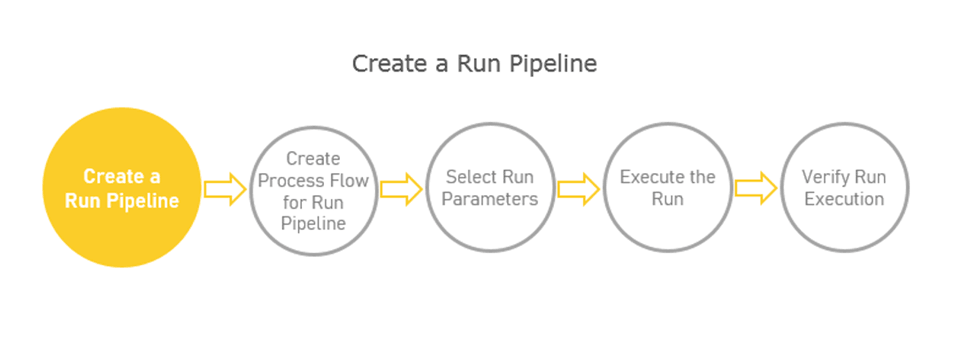
To create a new Run pipeline for Insurance Liability Contracts Data Load Process in the Process Modeler, follow these steps:
1. From OFSAA Home, select Oracle Insurance Data Foundation, click Administration  .
In the Information Domain list, select the information
domain required for OIDF. Then click the Process Modelling
Framework tile. A submenu is displayed. Click Process
Modeller to access the Process Modeler
page.
.
In the Information Domain list, select the information
domain required for OIDF. Then click the Process Modelling
Framework tile. A submenu is displayed. Click Process
Modeller to access the Process Modeler
page.
2. In the Process Modeler page, click  .
.
3. The Process Details page is displayed.
Figure 58: Process Details page
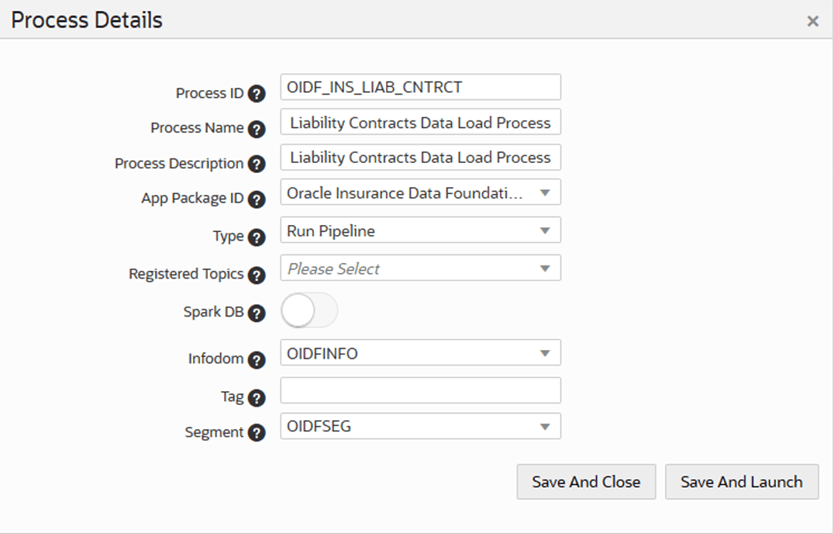
Enter or select the required values for each field.
Table 34: Process Details page field names and description
Field Name |
Description and instruction |
Process ID |
Enter a unique and easily recognizable value. |
Process Name |
Enter a unique and easily recognizable value |
Process Description |
Enter a unique and easily recognizable value |
App Package ID |
Select the required application package in which the process must be created from the drop-down list. |
Type |
Select the required process type from the Type drop-down list. The options are as follows: · Business Process Pipeline · Run Pipeline · Stream Pipeline |
Registered Topics |
NOTE: This functionality is currently not applicable to OFSBCE. |
Spark DB |
Enable the Spark DB option if you are executing the Run for Hive metadata. |
Infodom |
Select the information domain from the Infodom drop-down list in which the Run Pipeline must be created. The list displays all the infodoms mapped to the applications configured in your OFSAA instance. |
Tag |
Enter the text that can be used as search keywords or helpful in defining a relationship between two or more Pipelines. |
Segment |
Select the application segment. The options are as follows: · OIDFSEG: OIDF segment |
4. To save the details and launch the process flow designing page, click Save And Launch. Or, to save the details and close the Process Details page, click Save And Close.
After you select Save and Launch in the Process Details page, a blank process flow designing page opens.
Figure 59: Process Flow Page
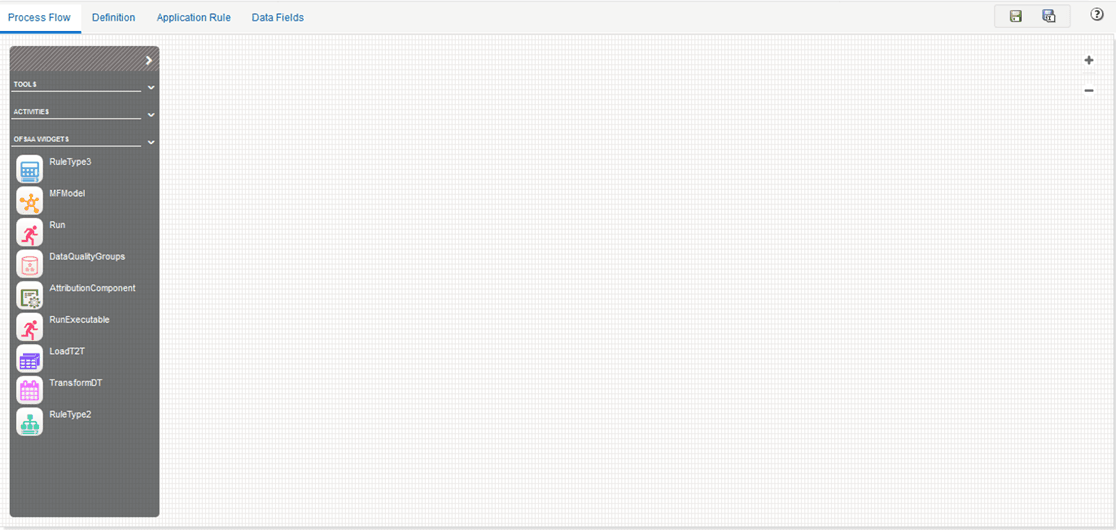
The Process Flow tab contains a floating toolbar and a drawing canvas. Use the drawing canvas to design the process flow with the Tools, Activities, and OFSAA Widgets components available in the floating toolbar. You can design the process flow diagrams for all three types of processes (Business Process Pipeline, Run Pipeline, and Stream Pipeline).
To design a process flow diagram for any Run Pipeline, see the Run Pipeline section, and to use several components available in the Process Flow tab, see the Components for Designing Your Process Flow section in the Oracle Financial Services Analytical Applications Infrastructure Process Modelling Framework Orchestration Guide Release 8.1.0.0.0.
Figure 60: Create Process Flow for Run Pipeline
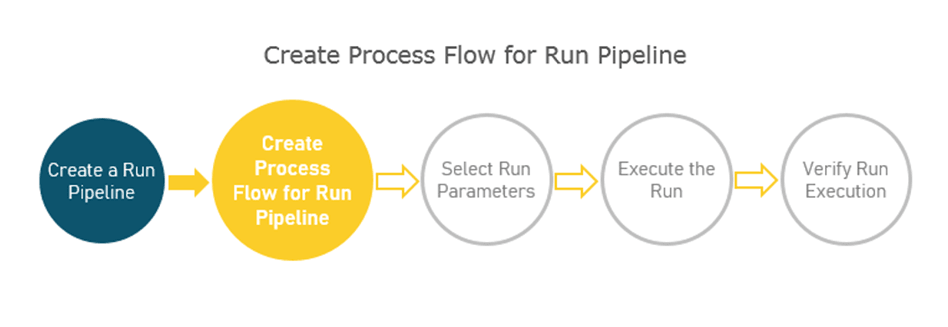
To create a process flow diagram for an Insurance Liability Contracts Data Load Process (a Run Pipeline for the Fact Common Policy Summary T2T execution) follow these steps:
1. Use the drawing canvas with the LoadT2T widget as the base. In the illustration, each LoadT2T widget represents each of the Insurance Liability Contracts Data Load Process for the Fact Common Policy Summary T2T. The LoadT2T widgets are executed in parallel.
Figure 61: Insurance Liability Contracts Data Load Process Flow Design
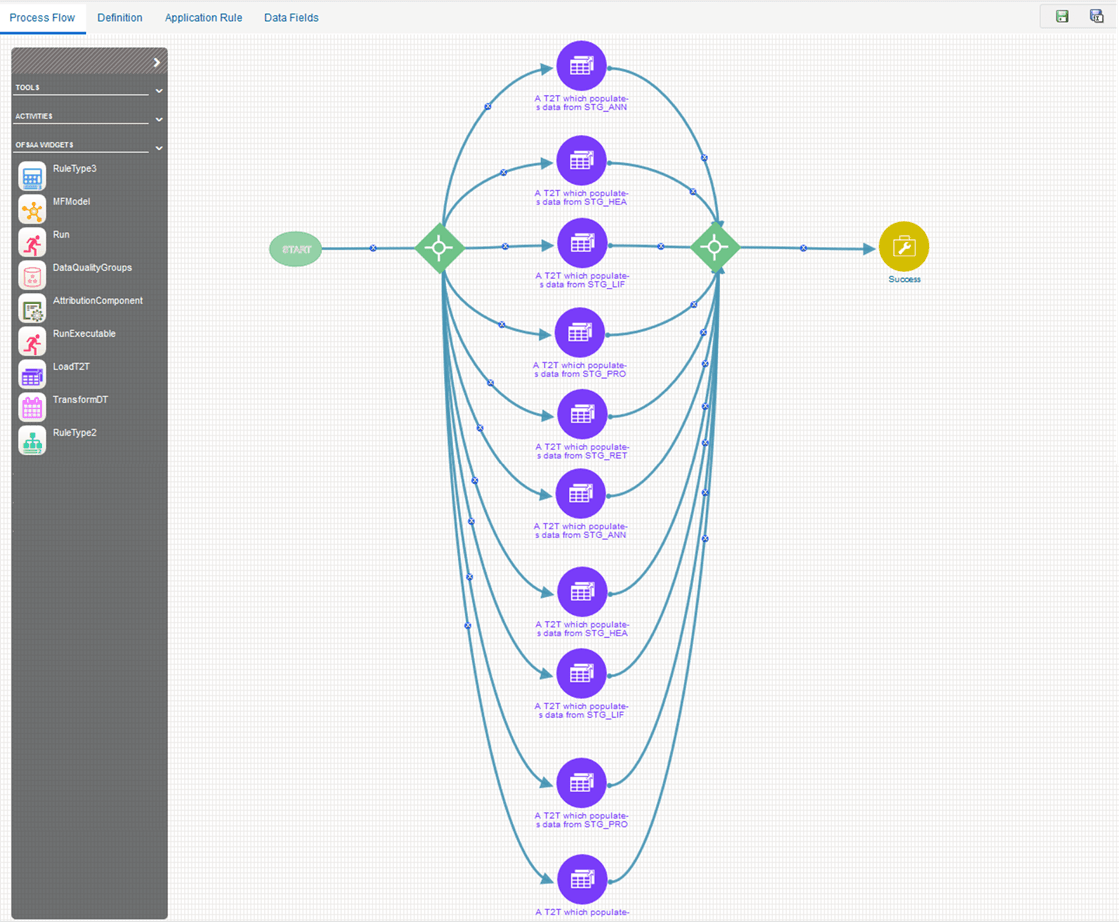
2. Double-click a LoadT2T widget to configure the details related to its Activity, Transitions, and Notifications.
Figure 62: Insurance Liability Contracts Data Load Process with LoadT2T widget – Add Activity Details
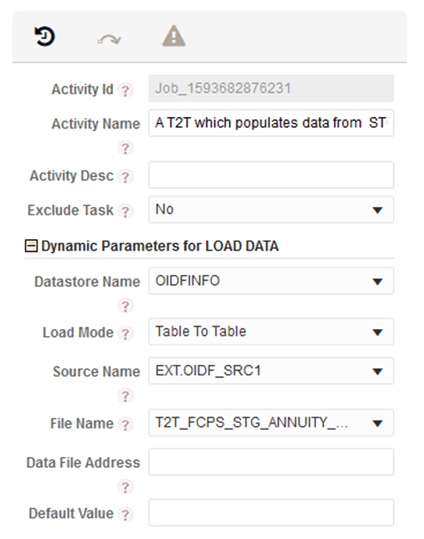
Figure 63: Insurance Liability Contracts Data Load Process with LoadT2T widget – Add Transitions Details
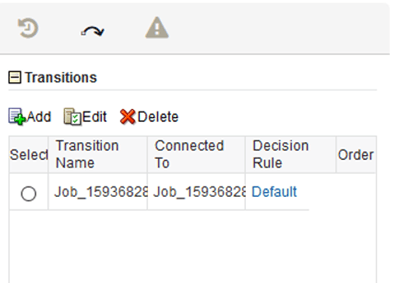
3. On the drawing canvas, select the Definition, Application Rule, and Data Fields tabs to see the respective details.
NOTE |
To create an Application Rule, see the Application Rules section, and to create a Data Field, see the Data Fields section in the Oracle Financial Services Analytical Applications Infrastructure Process Modelling Framework Orchestration Guide Release 8.1.0.0.0. |
§ Definition tab details
Figure 64: Insurance Liability Contracts Data Load Process with Definition Tab Details

§ Application Rule tab details: You can add or modify or delete the Rule details.
Figure 65: Insurance Liability Contracts Data Load Process with Application Rule Tab Details

§ Data Fields tab details: Add, modify, delete, or view the Data Field details.
Figure 66: Insurance Liability Contracts Data Load Process with Data Fields Tab Details
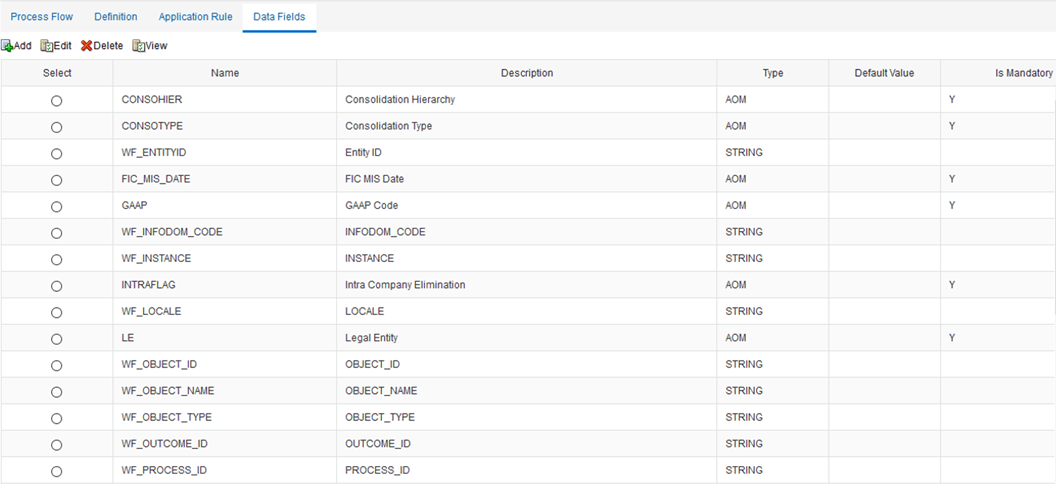
4. In the Process Flow tab, click to save
the process flow.
to save
the process flow.
To execute the created Run pipeline (process), see the Select the Run Parameters and Execute the Run section.
After a Run pipeline (process) is designed and defined in the process flow diagram, you must assign values to the Run parameters, and execute the Run. You can execute a Run Pipeline on the UI or using a command-line utility called wfExecExternal.sh.
Figure 67: Select Run Parameters and Execute the Run
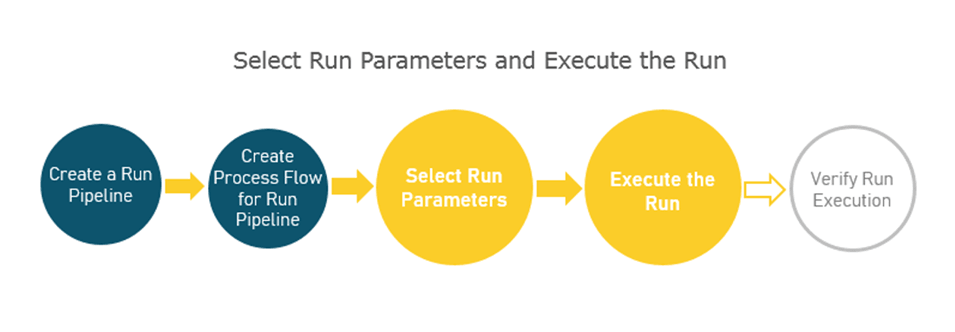
To select the Run parameters and execute the Run, follow these steps:
1. In the Process Modeler page, click  corresponding
to the Balance Computation Management Ledger Run process that must be
executed. Click Execute Run.
corresponding
to the Balance Computation Management Ledger Run process that must be
executed. Click Execute Run.
Figure 68: Insurance Liability Contracts Data Load Process - Select Execute Run
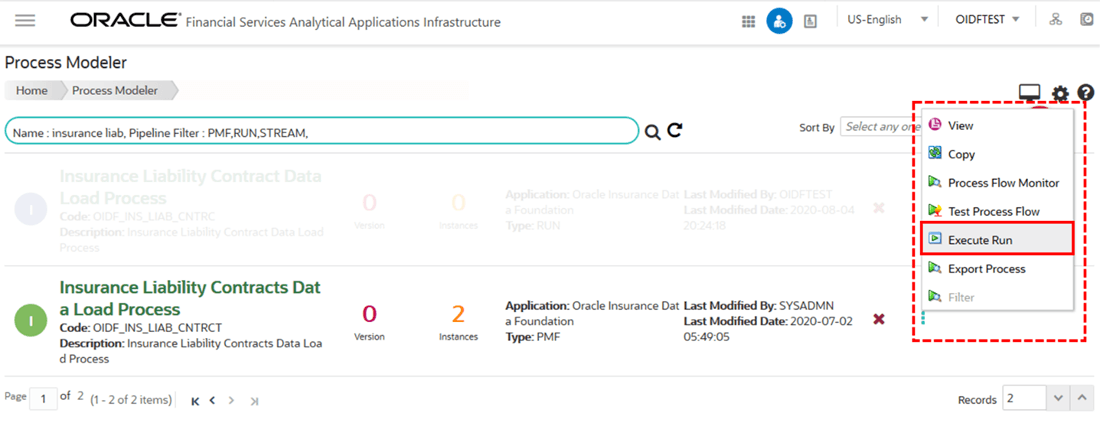
2. The Select Run Params page is displayed. This page consists of the Run parameters specific to the Balance Computation Management Ledger process.
Figure 69: Insurance Liability Contracts Data Load Process - Select Run Params Page
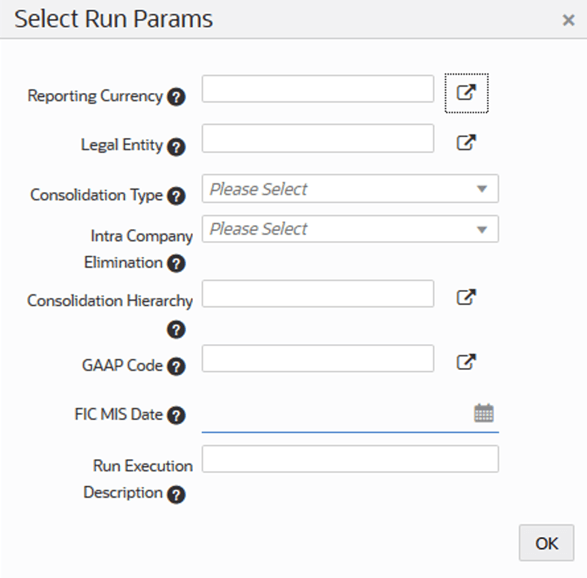
Select or enter the required values for each field as follows.
Table 35: Insurance Liability Contracts Data Load Process - Select Run Params page field names and description
Field Name |
Description or Instruction |
Reporting Currency |
Use the icon
|
Legal Entity |
Use the icon
|
Consolidation Type |
Select the Consolidation Type of legal entities on a solo or consolidation basis. In a Solo Run, only the selected legal entity is used. In a Consolidated Run, along with the selected legal entity, all its child legal entities are also used. |
Intra Company Elimination |
Select the Intra Company Elimination type to eliminate (YES) or skip the elimination (NO) of Intra Company Accounts during a Consolidated Run. |
Consolidation Hierarchy |
Use the icon |
GAAP Code |
Use the icon |
FIC MIS Date |
Use the calendar icon |
Run Execution Description |
Enter a longer description of the Run. |
3. When you click OK, the Run execution begins. The Select Run Params page closes.
NOTE |
The execution of the Insurance Liability Contracts Data Load Process is triggered using the selected FIC MIS DATE. The Run SKey is generated and inserted into the DIM_RUN table. For the Run SKey generated, the corresponding user-selected Run parameters are inserted into the RUN_EXE_PARAMETERS table. |
4. To verify the Run execution status of the Balance Computation Management Ledger process, see the Verify the Run Execution section.
5. To abort, resume, or rerun the process, see the section Abort, Resume, or Rerun the Process.
In the Process Monitor page,
click  corresponding
to the Run Pipeline process that must be aborted, resumed, or rerun. Then
select Abort, Resume,
or Re-Run.
corresponding
to the Run Pipeline process that must be aborted, resumed, or rerun. Then
select Abort, Resume,
or Re-Run.
Figure 70: Process Monitor with Re-Run, Abort, and Resume options

The Abort feature helps you to abort a Run Pipeline (process), which is in the process of execution. To abort a Run process execution, follow these steps:
1. In the Process Monitor page, click  corresponding
to the Run process that must be aborted, and then select Abort.
corresponding
to the Run process that must be aborted, and then select Abort.
2. The Abort Process Execution page displays. To abort the Run process execution, enter comments, and click OK.
Figure 71: Abort Process Execution Page
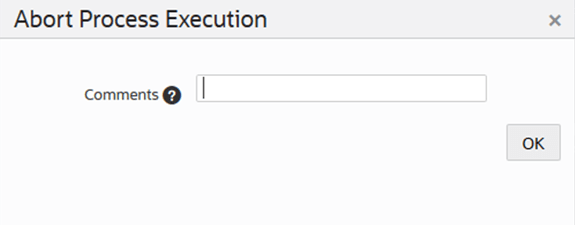
You can resume a Run Pipeline (process), which is not executed successfully, explicitly interrupted, canceled, or put on hold during the execution process. By resuming a Run process execution, you can continue its execution directly from the point of interruption or failure and complete executing the remaining tasks.
To resume a Run process execution, follow these steps:
1. In the Process Monitor page, click  corresponding
to the Run process that must be resumed, and then select Resume.
corresponding
to the Run process that must be resumed, and then select Resume.
2. The Restart Process Execution page displays. To resume the Run process execution, enter comments, and click OK.
Figure 72: Restart Process Execution Page

You can rerun a Run Pipeline (process), which was previously executed irrespective of its previous execution state.
To rerun a Run process execution, follow these steps:
1. In the Process Monitor page, click  corresponding
to the Run process that must be rerun, and then click Re-Run.
corresponding
to the Run process that must be rerun, and then click Re-Run.
2. The Re Run Process Execution page displays. To rerun the Run process execution, enter comments, and click OK.
Figure 73: Rerun Process Execution Page

After the Run pipeline (process) execution, you can check the status of the execution.
Figure 74: Verify Run Execution

To verify the Run execution, follow these steps:
1. To open the
Process Monitor page, in the Process
Modeler page, click  or select
Process Flow Monitor from the corresponding
or select
Process Flow Monitor from the corresponding
 process
sub menu
process
sub menu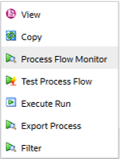 .
.
2. In the Process Monitor page, for the required Run pipeline that was executed, search the Run instance by Job ID or Process Name, and select the process instance.
Figure 75: Insurance Liability Contracts Data Load Process – Process Monitor Page – Select Job ID

3. A status page opens, which displays the execution status of the executed Run. In this illustration, the Insurance Liability Contracts Data Load Process is successfully executed.
Figure 76: Insurance Liability Contracts Data Load Process – Run Execution Status

To use a standard out-of-the-box Run pipeline for OIDF functions, see the Use Standard OIDF Run Pipelines section.
For information about the complete functioning of the PMF, see the Oracle Financial Services Analytical Applications Infrastructure Process Modelling Framework Orchestration Guide Release 8.1.0.0.0.